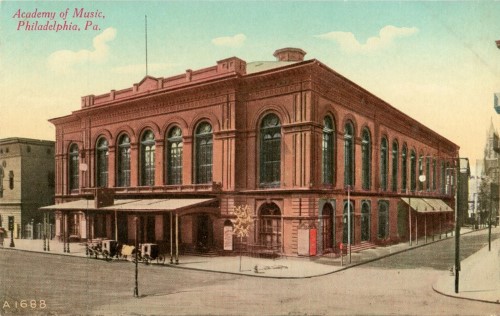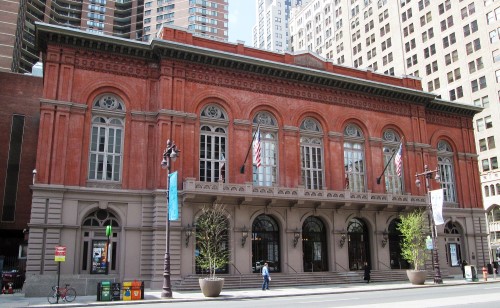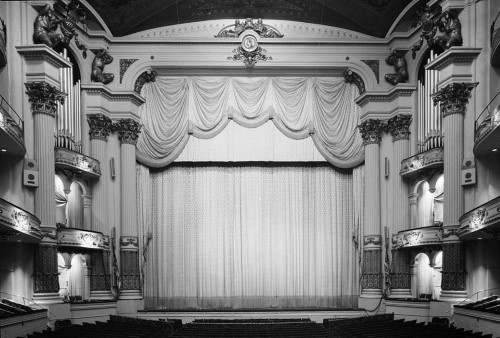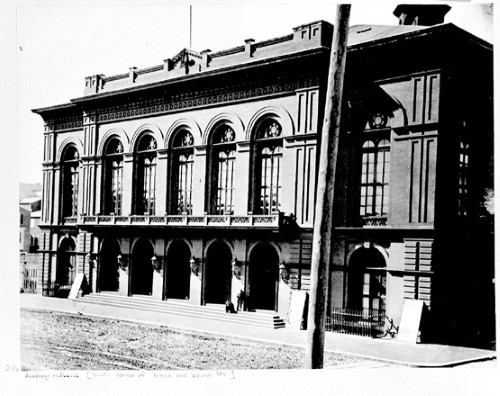The Academy of Music, also known as American Academy of Music, is a concert hall and opera house located at 240 S. Broad Street in Philadelphia, Pennsylvania. Its location is between Locust and Manning Streets in the Avenue of the Arts area of Center City.
The hall was built in 1855-57 and is the oldest opera house in the United States that is still used for its original purpose. Known as the “Grand Old Lady of Locust Street,” the venue is the home of the Pennsylvania Ballet and Opera Philadelphia. It was also home to the Philadelphia Orchestra from its inception in 1900 until 2001, when the orchestra moved to the new Kimmel Center for the Performing Arts. The Philadelphia Orchestra still retains ownership of the Academy.
The hall was designated a National Historic Landmark in 1962.
The Academy of Music held an inaugural ball on January 26, 1857. At the time The New York Times described the theater as “magnificently gorgeous, brilliantly lighted, solidly constructed, finely located, beautifully ornamented” but went on to lament “all that lacks is a few singers to render it ‘the thing’.”
The theatre had its first opera production, and what was billed as its formal opening, a month later on February 25, 1857 with a performance by the Max Maretzek Italian Opera Company of Verdi’s Il trovatore starring Marietta Gazzaniga as Leonora, Alessandro Amodio as Count di Luna, Zoë Aldini as Azucena, Pasquale Brignoli as Manrico, and Max Maretzek conducting.
Maretzek, who was already presenting operas at the Academy of Music in New York City and at the Chestnut Street Theatre in Philadelphia since 1850, brought his company back annually to the Academy of Music in Philadelphia through 1873. Due to his association with both the Philadelphia and New York City Academy of Music venues, his company was sometimes referred to as the Academy of Music Opera Company.
1870. Academy of Music.
The Academy has been in continuous use since 1857, hosting many world-famous performers, conductors and composers, and a significant number of American premieres of works in the standard operatic and classical repertoire. Noted operas that had their American premieres there include Strauss’s Ariadne auf Naxos, Gounod’s Faust, and Wagner’s The Flying Dutchman. In 1916, Leopold Stokowski conducted the Philadelphia Orchestra in the American premiere of Mahler’s Eighth Symphony (the Symphony of a Thousand).
The list of artists who have performed at the Academy of Music, from the 20th century, includes such figures as Gustav Mahler (1860-1911), Richard Strauss (1864-1949), Sergei Rachmaninoff (1873-1943), Pjotr Iljitsj Tchaikovsky (1840-1893) Enrico Caruso (1873-1921), Igor Stravinsky (1882-1971), Maria Callas, Aaron Copland, Vladimir Horowitz, Anna Pavlova, Luciano Pavarotti, Itzhak Perlman, Artur Rubinstein, Isaac Stern and Joan Sutherland among many others. After the Philadelphia Orchestra moved to the Kimmel Center, the 21st century brought more non-classical artists to the Academy.
Design
An architectural competition for the Academy’s design was announced in October 1854 and was won by the Philadelphia firm of Napoleon LeBrun and Gustavus Runge. The groundbreaking ceremony was held on June 18, 1855, with President Franklin Pierce in attendance and the venue opened with a grand ball on January 26, 1857. The first opera performed there was the Western Hemisphere premiere of Giuseppe Verdi’s Il Trovatore, on February 25 of the same year.

In order to reserve as much of the budget for the interior as possible, the architects designed a relatively plain brick and brownstone exterior that could be clad in marble if funds became available later. The ornate auditorium has an “open horseshoe” shape and proscenium columns with elliptical cross-sections in order to provide more direct sight lines from the seats in the side balconies.
The auditorium is enclosed by a solid three-foot brick wall with studding and pine boards lining the inner sides to prevent echoes and absorb sound. The upper balconies are recessed in a tiered fashion and supported by 14 Corinthian columns. The front of the first balcony is highly ornamented. The hall has a seating capacity of 2,389 which can be expanded to 2,509 when seats are placed in the orchestra pit and proscenium boxes.

Interior furnishings
The auditorium is graced by a large crystal chandelier, which measures 16 ft (4.9 m) in diameter, 50 ft (15 m) in circumference and weighs 5,000 lb (2,300 kg). When installed, the chandelier contained 240 gas jets; it was wired for electricity in 1900 and in 1957 was rewired and fitted with an electric-powered winch, allowing it to be lowered more easily.
It previously required 12 people working four-hours to lower it by hand. Atop the proscenium is a bas-relief bust of Mozart. Seated on the cornice above are the figures of Poetry, on the left, and Music, on the right. The elaborate carvings and gilded wood sculpture decorations throughout the auditorium are the work of Charles Bushor and Joseph A. Bailly and the ceiling murals of allegorical figures were completed by Karl Hermann Schmolze.
Acoustics
Controversy exists regarding the Academy’s acoustics. Although historically reported in Philadelphia for many decades as having excellent acoustics, some performers have been quoted as finding the Academy’s sound problematic. The cavernous spaces above the hall’s stage that allow for rapid set changes during an operatic performance tend to reduce resonance and confine the sound to the stage, giving the hall a dry acoustic.
Subsequently, the “Philadelphia Sound” of the Philadelphia Orchestra was, at least in part, the result of long-term efforts by Stokowski, later sustained by Eugene Ormandy, to compensate for this weakness. After some remodeling in the mid-1950s, Ormandy refused to make recordings with the Philadelphia Orchestra in the Academy. Riccardo Muti, Ormandy’s successor, also made his commercial recordings with the orchestra elsewhere.

Interior Academy of Music.
Various conductors have commented on the quality of the orchestral sound in the hall, as collected by Leo L. Beranek in his book Music, Acoustics & Architecture:
- Fritz Reiner commented: “The Academy has very good acoustics although somewhat dry. It is like an Italian opera house.”
- Pierre Monteux: “This hall is too dry; the tone stops instantly. The sound should have a more flattering carry-over.”
- Herbert von Karajan: “There is good orchestral balance, but the sound is too small. One doesn’t get full power from the climaxes.”‘
Extensive renovations beginning in 1994 have maintained the building’s architecture and made acoustic improvements.
Note: There is also a Academy of Music in Brooklyn.

